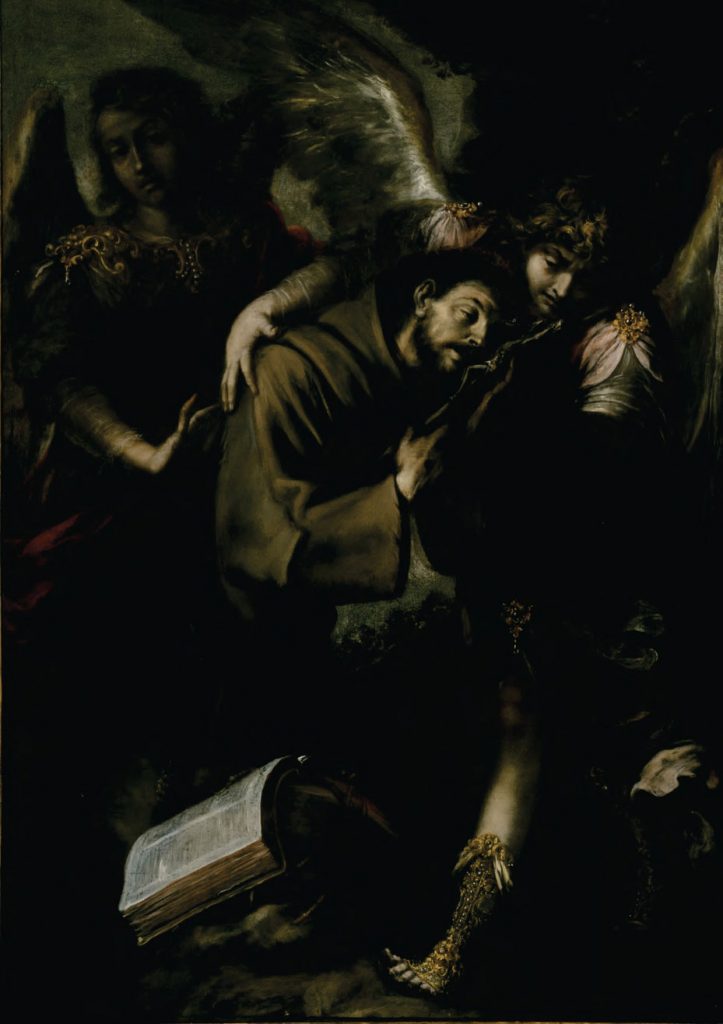The 'Ecstasy of Saint Francis' by Valdés Leal:
Long-term loan from the Santa Barbara Museum of Art to the Meadows Museum

Image above: Juan de Valdés Leal (Spanish, 1622-1690), The Ecstasy of Saint Francis, n.d. Oil on canvas, 61.5 x 42 in. Santa Barbara Museum of Art. Bequest of Suzette Morton Davidson
The career of Juan de Valdés Leal (1622-1690) parallels the closing decades of Spain’s Siglo de Oro and the period of decline of his native city of Seville. Less well known today than his contemporary, Bartolomé Esteban Murillo (1618-1682), Valdés Leal profited from wealthy patrons in Seville, and excelled not only as a painter, but also as a sculptor and printmaker. On a five-year loan to the Meadows Museum beginning this spring, The Ecstasy of Saint Francis from the Santa Barbara Museum of Art is an excellent example of the artist’s mature style, characterized by dramatic tenebrism, lively paint handling, and by the expressiveness of his compositions’ figures.
Valdés Leal chose for this work an infrequently depicted scene in the life of Saint Francis of Assisi: the moments immediately following his stigmatization, which according to his first biographer, Thomas of Celano (c. 1200-c. 1255), occurred in September of 1224. Following a forty-day fast in the Apennines, Saint Francis experienced a vision. A six-winged seraph flew toward him, and was subsequently nailed to a cross. When the vision subsided, the saint received the wounds of Christ in his hands and feet. Here, the painter depicts the saint swooning in the arms of the angel, the Stigmata visible in his right hand. Saint Francis holds the crucifix in adoration, his eyes heavy lidded from the rapturous experience. At Francis’s feet lies the open New Testament, with his flagellum draped over its pages.
This particular composition corresponds most closely to two works: Orazio Gentileschi (1563-1639), Saint Francis in Ecstasy (c. 1607) at the Museo del Prado, and Giovanni Baglione (c. 1566-1643), Ecstasy of Saint Francis (1601), at the Art Institute of Chicago. Interestingly, Baglione’s painting, like that by Valdés Leal, was once a part of the collection of philanthropist and collector Suzette Morton Davidson. This type of image was made popular in late fifteenth-century Italy by Michelangelo Merisi da Caravaggio (1571- 1610). Similar Italian compositions showing an angel comforting Saint Francis were in circulation and could have been source materials for this composition. While it was more common to depict the event as it unfolded on Mount Alverno, including in the composition the saint’s disciples – usually Brother Leo – here Valdés Leal excludes extraneous detail. Following Caravaggist templates of cropping the composition to bring the drama of the scene to the foreground, Valdés Leal’s representation of the saint draws the viewer in to witness the fervor of emotion of Saint Francis and his attendant angel. The confrontational nature of this image thus connects the viewer intimately to the scene. In Counter-Reformation Spain, the picture’s message of emulating the saint’s devotion to God would have been readily understood.
While little is known about Valdes Leal’s early training, it is assumed that he apprenticed in Seville, where he would have been acquainted with the work of Juan de Roelas (c. 1560-1624) and Francisco Herrera the Elder (c. 1590-c. 1654). The earliest surviving records on Valdés Leal are of his marriage in 1647 in Córdoba and he is documented working between Seville and Córdoba throughout the 1650s. In his biographic El parnaso español pintoresco laureado (1715-1724), Antonio Palomino records Valdés Leal as having traveled to Madrid in 1661 to study works in the royal collections and at El Escorial, although like much of Valdés Leal’s biography, what works of art he was able to see in and around Madrid deserves further study.
While his style is markedly different from that of his contemporary and rival painter Murillo, the two artists worked together on projects in Seville and both were integral to the founding of the Real Academia de Belles Artes in Seville, the first art academy established in Spain. Along with the painter’s Joachim and the Angel (1655-1660) from the Meadows collection, The Ecstasy of Saint Francis will be displayed with other Sevillian works from the Museum’s holdings to further the understanding of this Baroque master.
No Catalogue Available
Carrie Sanger
Marketing & PR Manager
chunnicutt@smu.edu
214.768.1584










